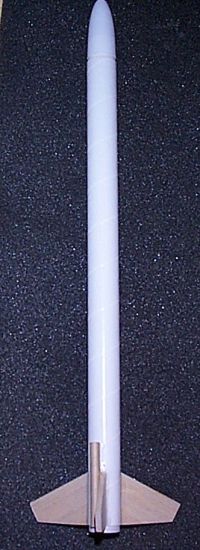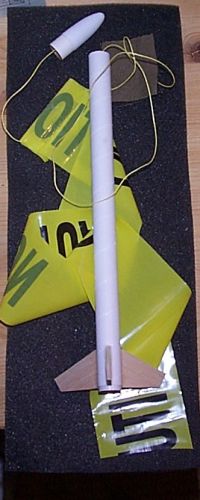| Construction Rating: | starstarstarstarstar_border |
| Flight Rating: | starstarstarstarstar_border |
| Overall Rating: | starstarstarstarstar_border |
| Manufacturer: | Pratt Hobbies  |
 Brief:
Brief:
Single Stage sport model rocket with streamer recovery.
Construction:
The parts list:
- 1 white body tube, 12" by .8" OD
- 3 laser cut 1/8" balsa fins
- 1 plastic nose cone, approximately 1 3/4", Parabolic shape
- 1 cardboard shoulder tube, goes into nose cone.
- 1 cardboard "thrust ring"
- 1 motor mount tube
- 1 Kevlar shock cord (not elastic, approximately 48"), three ply Kevlar cord
- 1 launch lug
- 1 cloth square heat shield
- 1 plastic streamer made from "Caution" tape, 23" by 3"
PROs: Very easy kit to build. Eight third graders (all age 9 or 10) with a parent's assistance were able to assemble the entire kit (minus finishing) in just over an hour. This included description of the kit and explaining the installation order of parts. The "fin jig" holds body stable as fins are glued on and "Caution" tape streamer got attention of the kids. White paper body tubes. Can be decorated with markers and acrylic paints.
CONs: End of Kevlar shock cord frays. Type of glue is important. We used Weldbond and Super Tacky Glue.
Kevlar shock cord did not feed easily through body tube for two boys, had to weigh end of shock cord (with a launch lug) to feed through quickly (and believe me, quick is important with third graders). Passing Kevlar cord through holes in Engine mount tube was a little tricky. following instructions to the letter caused a small problem.
This kit was purchased as a "bakers dozen" for a cub scout pack direct from the manufacturer. All of the cubs were third graders, so the kit had to have the following characteristics:

- Use 18 MM A engines.
- No cutting of fins.
- Easy to build.
- Under $5.00 for the kit (as we had an $8.00 budget per boy including engines.)
Supplies:
- Masking tape
- Scissors
- Glue (Weldbond white glue, Super Tacky Glue, both available at many craft and hobby shops.)
- Rulers
- Paint brushes
The Super Six is a simple rocket to build and has some very interesting features not seen in many other low cost kits. The first innovation was a "fin jig", which is a small piece of engine mount tube which is glued to a piece of cardstock. Lines are printed on the cardstock to indicate where the fins go. Once the "jig" has dried, the jig is taped down and the body tube is slid onto the jig. Fins are then glued to the body tube. I prepped all of the jig well in advance of the building session so we did not have to wait for the jigs to dry.
The second innovation was the use of Kevlar for the shock cord and a fireproof fabric (Nomex) square instead of wadding.
Each of the cubs was able to line up the fins correctly and look down from the top to see if the fins were straight.
While the fins dry, the instructions guide you through the assembly of the nosecone, which entails threading the Kevlar shock cord through a hole in a short cardboard tube, tying with a square knot, and gluing the short cardboard tube in the nosecone. The nose cones are thin styrene, and if handled too roughly, will crease. After assembling the nose cone, the streamer is slid over the shock cord and then a small rectangle of some fireproof fabric (like Nomex) is slid onto the shock cord. By this time, the fins should be dry enough for handling. One of our cubs did not use enough glue and a fin came loose.
The body tube was removed from the jig and the shock cord passed through the body. The instructions stated that the "thrust ring" should be glued inside the motor mount tube, then the shock cord passed through a small hole in the side of the tube. Doing it this way makes it hard to feed the shock cord through the hole. We found that at least one kit had the thrust ring blocking this hole. We found it easier to slide the thrust ring on the shock cord, thread the shock cord through the hole in the engine mount, then glue the thrust ring into the engine mount, and tie off the shock cord. The engine mount is then glued into the body tube.
We also made the mistake of adding a fillet of glue too soon. On two of the rockets, this loosened up the fins, requiring them to be glued again. This happened with kits using the Super Tacky Glue, but not the Weldbond. With a statistical sample of two, there is no way of really knowing if it was due to the glue or not.
The other issue we ran into was the ends of the shock cord unraveling. It is made of three ply twisted Kevlar, and the ends can unravel fairly easily. We trimmed them with scissors, placed a drop of glue on the end, and were good to go.
Finishing:
PROs: finishing was remarkably easy. We did not seal and fill the balsa wood fins, but just let the boys go at it and design as they wish. A light sanding and sealing of the fins would give a very smooth finish. The kit shipped with three stickers, one of a British flag, one of an American flag, and one with "Super six" printed on it. These stickers appeared to be clear label paper and ink jet printing. We let the boys paint the bodies and fins with water based acrylics and used model paint for the nose cones.
CONs: none that I could think of.
Construction Rating: 4 out of 5
Flight:
The manufacturer recommends staying with the A or B size 18mm motors, specifically A6-4, A8-3, and B6-4. We used Estes A8-3 motors, as we had limited space. Motors are held in with masking tape, wrapped around the motor and the bottom of the body tube.
The Super Six is equipped with a fireproof square of fabric, and a Kevlar shock cord, so the manufacturer states that wadding is not necessary. Loading the streamer was a little difficult for some boys, although a child over 11 years of age should have no difficulty. The fireproof fabric square is partially inserted into the body tube, then the folded and rolled streamer is carefully placed inside the square and pushed down into the body tube. It is important that the fireproof fabric square completely cover the end of the streamer, or the ejection charge will melt the streamer.
The shock cord is very long--in our kits it was around 48". It must be carefully folded into the body tube. A parent performed this as all of the scouts had tangling issues. Again, a child of 11 years or older should have no trouble with this, but 9 year old third graders did.
We had 14 launches with 7 different rockets. All of the flights were remarkably straight, given the slight imperfections in fin alignment. The estimated height of these launches was between 45 and 50 meters, calculated using the average of two different altitude trackers 15 meters from the launch site.
Two casualties occurred: one rocket lost the nosecone completely with the Kevlar cord. We did recover the streamer and the rocket. On another rocket, the Kevlar cord ripped loose from the cardboard nose cone insert, so a new hole had to be punched in the nosecone insert and have the cord reattached.
Recovery:
The shock cord is a 48" length of Kevlar cord and is attached to the top of the engine mount inside the rocket through a cardboard nose cone shoulder.
The descent of the rocket was a little slower than expected, but none of the rockets were damaged--not even the two that bounced off of asphalt. One rocket experienced a little burning of the streamer on the second flight, so this one will next fly with wadding as well as the fireproof fabric shield.
I would recommend a slightly narrower streamer, although the boys loved the "Caution" tape. Also, I would recommend shorter shock cord material as 48" was difficult to pack without tangling. One rocket experienced tangling of the shock cord, but the streamer still deployed and the rocket was recovered safely.
Lastly, I would recommend gluing paper inside the nosecone shoulder to reinforce and hold down the shock cord to the nosecone.
Flight Rating: 4 out of 5
Summary:
This was a very good building experience for 9 year olds, but they definitely need adult assistance.
PROs: Instructions were clear. Fins were cleanly cut and minimal sanding/finishing is needed. Value for price was excellent. Inclusion of Fin Jig was also excellent--all kits should have this. Fireproof heat shield is a great idea, although they could have been just slightly larger. Flights were excellent. I attribute this to the inclusion of the fin jig.
CONs: Kevlar cord frays easily on the ends. Attachment to motor mount is tricky if following instructions as printed. Nose cone attachment to cardboard shoulder must be glued well.
Overall Rating: 4 out of 5
Other Reviews
- Pratt Hobbies Super Six By Daniel Kirk
Brief: Beginner's streamer recovery model. Small and light enough for competition. Construction: The kit includes: One (1) 18mm x 12 in body tube, three (3) pre-cut plastic fins, one (1) CMR-style nose cone, one (1) Kevlar ® shock cord, and one (1) Nomex ® parachute protector. NOTE: This review is focused on the Simple Six which has been updated to the Super Six. The ...
 |
 |
Flights
 |
 |
Sponsored Ads
 |
 |












M.S. (September 1, 2000)